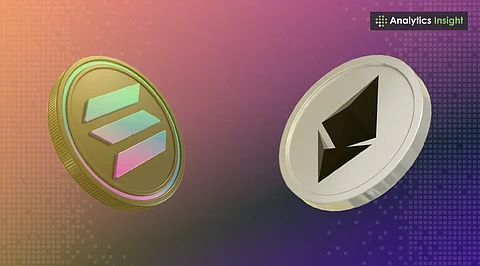Technology
Ethereum and Solana Compete for Dominance in 2025 Altcoin Market

The cryptocurrency landscape is set for significant developments in 2025, with two altcoins, **Ethereum (ETH)** and **Solana (SOL)**, positioned to capture investor interest. Each platform offers unique advantages that cater to different market segments, making them prominent players in the realms of decentralized finance (DeFi), non-fungible tokens (NFTs), and artificial intelligence (AI)-driven technologies.
Ethereum: The Institutional Powerhouse
**Ethereum** continues to solidify its status as the largest smart contract platform, processing approximately **30 transactions per second (TPS)**. This capability is enhanced through various layer-2 solutions, such as **Arbitrum** and **Optimism**. A notable milestone for 2025 is the anticipated **Pectra upgrade**, which promises to introduce enhanced wallet functionality, flexible staking options ranging from **32 to 2,048 ETH**, and improved interoperability across decentralized applications.
With a focus on security, decentralization, and long-term sustainability, Ethereum remains a cornerstone of the DeFi and NFT markets. Its dominance is reflected in developer activity and total value locked (TVL), which exceeds **$30 billion** in institutional assets. Analysts project that if demand for ETH remains strong, its price could rise to between **$5,000 and $8,000**.
Despite these strengths, Ethereum faces challenges, particularly regarding gas fees. While layer-2 solutions have reduced costs, average transaction fees hover around **$5 to $6**, with spikes exceeding **$15** during peak usage. Nevertheless, the platform’s robust security and liquidity make it a preferred choice for conservative investors.
Solana: Speed and Affordability
In contrast, **Solana** has carved out a niche as one of the fastest and most cost-effective blockchains, achieving real-world transaction throughput of **2,000 to 4,000 TPS**, with a theoretical maximum of **65,000 TPS**. The platform boasts transaction finality of just **0.4 seconds**, making it well-suited for high-frequency trading, decentralized exchanges, and AI integrations.
Although smaller than Ethereum’s ecosystem, Solana is rapidly expanding, attracting interest from retail investors in NFTs and meme coins. The average transaction fee on Solana is remarkably low, ranging from **$0.0001 to $0.0025**, which has facilitated robust adoption in the NFT trading space. Furthermore, Solana offers higher staking returns, with yields of **7 to 8 percent annually**, appealing to yield-seeking investors.
However, Solana’s growth is not without its hurdles. The network has experienced outages in the past, and regulatory scrutiny has increased, with discussions around whether SOL could be classified as a security. Additionally, Solana’s ecosystem remains less mature compared to Ethereum, which could impact liquidity and developer engagement.
Comparative Outlook for 2025
Forecasts for both Ethereum and Solana in 2025 vary widely based on market conditions. For Ethereum, the outlook is generally bullish, with strong ETF inflows and successful developments like the Pectra upgrade potentially driving ETH prices to new heights near **$8,000**. Conversely, if institutional demand stabilizes, ETH may consolidate between **$4,500 and $6,000**. Bearish scenarios could see ETH prices fall to between **$2,500 and $3,200** due to sustained competition and regulatory challenges.
Solana’s prospects also depend on its ability to maintain stability and attract institutional interest. In positive scenarios, SOL could surge past **$500**, while a steady climb to between **$250 and $350** seems likely as it consolidates its position in NFTs and high-speed applications. On the downside, further outages or regulatory scrutiny could depress SOL prices to between **$120 and $180**, although it would likely remain a leading altcoin.
Investors face a choice between two compelling options in 2025. Those seeking security, decentralization, and institutional backing may favor Ethereum, while those prioritizing speed, affordability, and high staking rewards might lean towards Solana. For many, a balanced approach of holding both ETH for stability and SOL for growth could provide a strategic advantage in navigating the evolving cryptocurrency market.
-

 Technology5 months ago
Technology5 months agoDiscover the Top 10 Calorie Counting Apps of 2025
-

 Health2 months ago
Health2 months agoBella Hadid Shares Health Update After Treatment for Lyme Disease
-

 Health3 months ago
Health3 months agoErin Bates Shares Recovery Update Following Sepsis Complications
-

 Technology4 months ago
Technology4 months agoDiscover How to Reverse Image Search Using ChatGPT Effortlessly
-

 Technology1 month ago
Technology1 month agoDiscover 2025’s Top GPUs for Exceptional 4K Gaming Performance
-

 Technology2 months ago
Technology2 months agoElectric Moto Influencer Surronster Arrested in Tijuana
-

 Technology5 months ago
Technology5 months agoMeta Initiates $60B AI Data Center Expansion, Starting in Ohio
-

 Technology5 months ago
Technology5 months agoRecovering a Suspended TikTok Account: A Step-by-Step Guide
-

 Health4 months ago
Health4 months agoTested: Rab Firewall Mountain Jacket Survives Harsh Conditions
-

 Lifestyle5 months ago
Lifestyle5 months agoBelton Family Reunites After Daughter Survives Hill Country Floods
-

 Technology4 months ago
Technology4 months agoHarmonic Launches AI Chatbot App to Transform Mathematical Reasoning
-

 Technology3 months ago
Technology3 months agoUncovering the Top Five Most Challenging Motorcycles to Ride





















